The Re-Imagination of Performance
Note: This article was published in the Winter 2009 issue of the Guitar Foundation of America’s Soundboard. My original intention was to write a four-part series of articles that explored aspects of performance—portamento, rubato, tempo modification, accent and articulation—that are often neglected in the training of guitar students. The article below consists of introductory material to the series followed by a detailed look at portamento. Other than correcting a small mistake I found after publication and the addition of a photo, I have left the article as it originally appeared in 2009. (You’ll see the heading “Part One: Portamento” in the second half of this article. Parts two, three, and four were never published.)
What is to be insisted upon is that the poet must develop or procure the consciousness of the past and that he should continue to develop this consciousness throughout his career.
—T.S. Eliot[1]
INTRODUCTION
Many poorly trained modern guitarists appear to have confused the mixed blessings of low expectations, like Johnson’s dog, with the accomplishment of something significant, such as the realization of Andrés Segovia’s goals of establishing the guitar as an accepted concert instrument,[2] goals which imply sustained attention to interpretive creativity in performance and pedagogy by serious professional and amateur practitioners. This conflation remains largely unremarkable because it occurred in the late twentieth century, a period in which subjective expression and imagination in musical performance in general flattened out and shed the remaining vestiges of Romantic performance practice. This is a complex subject with myriad causes, but the idea of the performer as a co-creator[3] with the composer was gradually replaced by a pernicious objectivity.
It is true that the guitar has reclaimed its important pedagogical heritage. We now know, for example, that Segovia based his 1945 edition of twenty studies by Fernando Sor on a nineteenth-century edition by Napoléon Coste;[4] we know of numerous earlier nineteenth-century guitar methods; we have been exploring hundreds of virtuoso concert pieces that were generally unavailable fifty years ago; we understand better the techniques that earlier guitarists used; we have explored physiology and its relationship to our technique. But there remains one thing we do not have: we have no nineteenth- or early-twentieth-century performers of great artistic stature describing their approach to the interpretive aspects of their art in any articulate and coherent way.
In “Essential Issues in Performance Practices of the Classical Guitar, 1770-1850,”[5] Richard Savino discusses stringing, right-hand technique, seating position, fingernails, the use of the left hand, and ornamentation, quoting liberally from nineteenth-century method books. Certainly these affect performance, but where is the real performance information, information about vibrato, portamento, rubato, information such as appears in works for voice, strings, and keyboard? The fault is not Savino’s. Where are the Hugo Riemanns, Pierre Baillots, Jean-Louis Duports, Friedrich Dotzauers, and Manuel Garcías for our instrument from whom we could glean this information? Authors of guitar books seem never to have been able to pass fully through the crucible that explores the technical exigencies of the instrument. Dionisio Aguado devotes a scant two pages to expression in his 1843 method, although some of the studies in his book contain expression marks, which is uncharacteristic of the guitar music of the period—but not for piano or violin music. Even later in the nineteenth and early twentieth centuries, there is a dearth of performance information comparable to writings by Ignacy Jan Paderweski, Josef Hofmann, Vladimir de Pachmann and others.
Given the absence of articulate artist-teachers from the past for our instrument, it will be instructive to explore the writings of some of the great pianists, singers, and instrumentalists who embody Romantic performance ideals and to draw upon recent studies of historic recordings, recordings that are undergoing a change in reception from the old-fashioned to the historically valuable.
A comprehensive study of Romantic performance practice is beyond the scope of these articles, and great artists of the past had a variety of approaches, but they all cherished the value of the artist as individual, whose freedom to assert artistic personality on the music was unchallenged by all but a few composers.[6] Legendary pianist Josef Hofmann was certain that he was doing justice to a work even when he departed from the composers own conception:
Pedantic adherence to the composer’s own conception is, to my mind, not an unassailable maxim. The composer’s way of rendering his composition may not be free from certain predilections, biases, mannerisms, and his rendition may also suffer from a paucity of pianistic experience. It seems, therefore, that to do justice to the work itself is of far greater importance than a slavish adherence to the composer’s conception.[7]
After discussing how “legitimate individuality” allows a performer’s thoughts to fuse with those of the composer, Hofmann adds, “A purposed, blatant parading of the player's dear self through wilful additions of nuances, shadings, effects, and what not, is tantamount to a falsification; at best it is ‘playing to the galleries,’ charlatanism. The player should always feel convinced that he plays only what is written.”[8]
PERFORMANCE AS ANALYSIS
How can the Romantic performers have it both ways? Only by seeing performance as analysis can we reconcile performers expressing both their individuality and “what is written.” The Romantic performance tropes employing portamento, vibrato, tempo modification, rubato, accent, and articulation, were used to highlight structural, harmonic, and melodic aspects of a composition and provide audiences with an aural analysis of a work, an analysis that was dependent upon the creativity and intellect of the performer. Daniel Barolosky points out that scholars “have come to see that performers often make interpretive decisions based on criteria similar to those that analysts themselves use, even though their method of analysis may not conform to academic norms. Yet we still have not adequately appreciated interpretive contributions of performers, at once analytic and creative.”[9]
In the hands of the most brilliant performers, Romantic performance gestures had a relationship to the Romantic compositional tropes, tropes that were created to express Romantic ideals. And what were these Romantic ideals? Jacques Barzun disabuses us of the notion that the Romantics lay about in an uncritical haze:
In the last years of the 18C in Germany and England, Romantic generated the -ist form to designate those dissatisfied with the neo-classic style and enthusiastic about new forms in art and thought. None of the motley meanings of romantic gives any help in understanding that outlook. It is obvious that an age that left scores of masterpieces in every art and original ideas still current cannot have been populated exclusively by men and women weak in judgment and continually lovelorn and subject to illusion. The one link between the temper of the period and the original meaning of the word is that Romanticism validated passion and risk. The two are inevitably connected; but as we shall see, they neither exclude reason, nor overlook the real. On the contrary, the spirit of adventure in Romanticism aims at enlarging experience by exploring the real.[10]
IMAGINATION
Imagination is what makes this exploration possible. The performance tropes mentioned above emphasize freedom over a fixed structure, freedom that is to be employed imaginatively. Barzun cautions us against the merely fanciful, which requires little effort (like the randomness favored by many modern artists). Romantic imagination was laced with wit and intelligence:[11] “The Romanticists’ point was in fact not an emotional point at all,” he told the New Yorker in 2007, “but an intellectual point about the emotional life of man.”[12]
How are we to imagine those scores for which there are no markings, which account for the majority of guitar scores? Whence comes our wit and intelligence and how is it manifested artistically? Are there late twentieth-century performance tropes that have insinuated themselves so cleverly between us and a work that we think we are expressing some innately artistic response to the music when we are really toeing a party line?
These are valuable questions, and all who would aspire to artistry must come to terms with their implications. How else are we to move from those “whose playing,” as expressed by Rachmaninoff, “seems all alike. It is like the meals served in some hotels. Everything brought to the table has the same taste,”[13] to the ideal suggested by Sigismund Stojowski?
The student should seek to break the veil of conventions provided by notation and seek a clearer insight into the composer’s individuality as expressed in his compositions. From this point of view, the so-called subjective interpretation seems the only legitimate one. In fact, the ones who pretend to be objective in the sense of being literal and playing strictly according to the marks of expression and admitting little elasticity in the interpretation of these are also, as [Anton] Rubinstein pointed out, subjective at heart. This may be more concisely expressed thus: Since all things of permanent value in music have proceeded from a fervid artistic imagination, they should be interpreted with the continual employment of the performer's imagination.[14]
Barzun tells us what imagination does: “Out of the known or knowable, Imagination connects the remote, reinterprets the familiar, or discovers hidden realities. Being a means of discovery, it must be called ‘Imagination of the real.’”[15] Simply put, in music performance, the exercise of Romantic performance traits, such as portamento, tempo modification, rubato, exaggerated phrasing, dynamic contrast, vibrato as ornament, overt virtuosity, and freedom with the score, serve as a prism that refracts a new conception of a piece. Before we discuss facets of that prism, though, we need to look at what has occluded them: the lack of artistic or interpretive editions for guitarists, an antipathy to the past, and a disdain for excellence and intellect.
THE CULT OF THE URTEXT
Clive Brown, in Classical and Romantic Performance Practice 1750-1900, discusses the “cult of the Urtext,”[16] of which guitarists have tended to make a fetish. Perhaps this was a justified reaction against early twentieth-century guitarists and editors regarding music of the past as a tabula rasa upon which they etched their own ideas. These ideas almost always dealt with the technical exigencies of getting the music on the guitar and often included changed notes and idiosyncratic fingerings, but no reference to historical technique. This editorial license was rarely of an artistic nature, and therein lies the problem: guitar music did not benefit from interpretive editions, such as those offered by Ferdinand David, Hugo Riemann, Carl Flesch, Arthur Schnabel, and many others, for other instruments. While editions such as these present their own set of editorial problems, at least they accustomed musicians to respond to phrase markings, dynamic markings, and other interpretive indications. Publictions such as Isaias Savio’s edition of Francisco Tárrega’s Capricho árabe[17] or Segovia’s editions of studies by Fernando Sor[18] have all of the disadvantages of early modern editions and none of their benefits.
It was against this background that Robert Spencer, whose library has been essential to the creation of facsimile and Urtext editions of lute and guitar music, could write about critical editions:
By critical edition, I mean that the original page has been reset or re-engraved, but remains a faithful copy in which nothing has been changed. During this century the word Urtext (German for “original text”) has been used strictly for this type of transcription. If critical comment is added to help the player, the Urtext becomes a critical edition. The vital point is that any editorial addition must be clearly distinguishable from the original music. Modern editions which do not show this distinction should not be used—they should be burnt![19]
It is in the lacuna of interpretive editions that the development of guitarists’ artistic sensitivities has languished. The proliferation of Urtext editions has demanded fealty to Brown’s “cult of the Urtext,” which has become the preferred text for many modern performers. Those influenced by the early music movement regard these editions as inviolable, with any deviation from the notes and original interpretive markings seen as an artistic transgression.[20] Yet Urtexts of guitar music, and the early publications upon which they are based, rarely contain meaningful interpretive information. They simply contain notes and sometimes fingering. Could this lack of interpretive detail, detail that appears in piano or violin editions, have prevented the musical imaginations of guitarists from developing?
But Urtexts are not without value. Early guitar editors often changed notes without telling us, the practice that Robert Spencer would consign to conflagration, and a glance at the Urtext edition would reveal any changes. Further, if the guitarist is steeped in the stylistic details of the period, and if the Urtext editions point to, confirm, or elaborate on a specific element of performance practice or technique, they become invaluable. For example, Sor’s fingering for thirds in his Op. 31, No. 15, and Op. 35, No. 15, provide models for the fingering of his Op. 6, No. 6, which was published without fingering.
To unschooled guitarists, however, obeisance to these editions has obviated performers’ awareness of the obligation of transcending the strict meaning of the notation through the use of modifications and artistic gestures. In the nineteenth century, the artistic quality of a performance was not judged by its degree of fidelity to the score, which is essentially a modern criterion.[21] That artists were expected to impress their artistic personality on the score was not something that was generally disputed. By joining as co-creator with the composer, performers felt they were better realizing the composer’s artistic intentions. That this occurred is verified by recordings from the early 1900s whose existence “provides a salutary lesson for students of performance practice, for the aural evidence often reveals things that are startlingly different from anything that might confidently be adduced from the [written] documentary evidence alone.”[22]
Guitarists don’t have an original phrasing model in their Urtext editions, and they don’t have a model of a later artist’s interpretive edition. There aren’t even interpretive editions containing ideas with which we can disagree. Bèrben’s 2001 volume of dozens of Andres Segovia’s transcriptions of music by Albéniz, Chopin, Debussy, Granados, Grieg, and others—which were actually transcribed from recordings—contains no interpretive indications at all, even when the original model had them.[23] What does this say about the performance tradition of guitar music? The implication here is that the recording is the primary text; the printed score is secondary to discovering the musical meaning, which is assumed to inhere primarily in Segovia’s performances. There is an appended note directing guitarists to Segovia’s recordings of the included works to determine whether to play a glissando or a portamento, which share the same sign in the printed music.
This is not a recent development. Compare Segovia’s 1947 transcription of Isaac Albéniz’ Mallorca, Op. 202,[24] with any published piano version, or any transcription by Miguel Llobet or Francisco Tárrega of music by Granados or Albéniz. The number of interpretive indications in the guitar versions is a fraction of what occurs in the piano versions, and the interpretive vibrancy guitarists bring to these scores is often a fraction of what it could be.
Perhaps modern musicians have also been influenced by the idea that the Urtext equals a clean text (and, by extension, a clean performance), and by a recording aesthetic that shies away from anything that might prove tiresome when heard again and again.[25] The results are anodyne readings devoid of nuance and individuality. Published guitar music, especially standard literature, has never been subject to any sort of consistent artistic or interpretive vision in print and we are the poorer for it.
ANTIPATHY TO THE PAST
Even the most casual concert-goer is aware that composers of different eras wrote in different styles. These styles were often a reaction against what went before, a search for something new, and the creative spirit responding to a different Zeitgeist. But what is less obvious is that different performance styles complement these compositional styles. Performers of different eras approached their musical texts differently than we do. By this, I don’t simply mean that one should use more rubato in a Romantic versus a Classical work; I mean, in the words of Margaret Bent, “different repertories of early music have their own grammars and their own dialects. As with ‘dead’ languages, these grammars are recoverable, enabling us to understand the written literature, to know quite a lot about how they were performed or pronounced, even without knowing what they really sounded like.”[26] As Jacques Barzun has pointed out in Dawn to Decadence, “different periods conceive differently and each must be granted its premise before one judges its conclusions.”[27] The obvious challenge here is to grant a work the premise of its own era instead of substituting an aesthetic premise of the present day. But how much of an era’s performance style, if any, inheres in an era’s compositional style? If we fail to answer this question, our interpretations will be marooned in an emotional and stylistic cul-de-sac.
How are we to understand the conceptions of earlier eras, which is prelude to granting them their premises? This is especially thorny when it comes to performance styles. Even when we have historical writings about, say, discretionary fluctuations of tempo within a piece, there is no way to measure the degree of flexibility; we can only know that some writers confirm that these fluctuations existed. Our understanding of degree is tethered to our respect for history; the anti-historical mind can only view the past against the background of a narcissistic present. Studying the past may not give us a definitive understanding, but ignorance of past traditions consigns us to a world of limited imagination.
In his Democracy in America of 1835, Alexis de Tocqueville may have been the first to identify America’s antipathy towards the past: “Those who went before are soon forgotten; of those who will come after, no one has any idea: the interest of man is confined to those in close propinquity to himself.”[28] We can use de Tocqueville’s recognition of America’s penchant for immediacy as the basis for the distinction between the requirements of commerce and the requirements of art.
The distinction became more pronounced as America became the chief producer of entertainment. Neal Gabler chronicles the rise of entertainment values and how these differ from artistic values. Chief among them is the capacity of art to effect an individual response from each person; art was directed at individuals. Entertainment’s success depends upon a large number of people having the same response. Gabler calls art inventional while entertainment is conventional: “… if artists seemed to create their work assuming that different spectators would have different experiences of it, entertainers created theirs by deploying familiar words, images, symbols, techniques or stories in an attempt to manipulate a spectator not only into having a particular experience, but in ensuring that every member of the audience would have the same experience.”[29] This reliance upon the formulaic keeps artists shackled to a set of values inimical to audiences having anything but a “passive response rewarded by fun.”[30] Further, the more artists rely on the same formulae, the more everyone will sound alike. But artists have a weightier obligation and must work to conceive a weightier set of values. The individuality cultivated by performers of the past ensured a variety of individual responses from their audiences. This individuality need not remain unobtainable by modern performers, but what’s required to reclaim it may be subversive.
EXCELLENCE AND INTELLECT AS SUBVERSION
To practice a musical instrument is to be subversive. In The Twilight of American Culture, Morris Berman quotes potter and art critic Rosemary Hill: “To make objects by hand in an industrial society, to work slowly and uneconomically against the grain, is to offer, however inadvertently, a critique of that society.”[31] In fact, anything handmade in this age of easily reproduced digital files and mash-ups is subversive. Software tools such as PhotoShop, GarageBand, and ProTools, have fostered the illusion that access to the tools of creativity is the same as providing access to creativity itself.
But art can no longer be subversive in the classical sense—an attempt to undermine repressive authority or established norms—because subversion has now become the lingua franca of the culture or, perhaps more accurately, something masquerading as subversion has. Subversion and creative freedom cancel themselves out or become meaningless because they can only be experienced in relation to established norms. When these norms are obscured by continuous and mindless violations, or by collective cultural amnesia, subversion and creative freedom vanish.[32]
What is really subversive now is adding excellence and intellect into an authentic creative mix. But society no longer admires excellence, at least in intellectual endeavors. What I have termed “authentic creativity,” for lack of a more useful term, requires a high level of expertise, expertise that requires years to develop. But consider the following, relayed by Andrew Keen in The Cult of The Amateur: How Today’s Internet Is Killing Our Culture. Keen describes his attendance at the prestigious Friends of O’Reilly camp in 2004, a retreat for Silicon Valley luminaries and visionaries. Over breakfast, a Friend of O’Reilly told Keen that “’noble amateurs’ would democratize what... he called ‘the dictatorship of expertise.’ The Web 2.0 was the most ‘awesomely’ democratic consequence of the digital revolution, he said. It would change the world forever.”[33] The concept has already infiltrated popular culture and influences our ideas about authorship and creativity, especially for the young. Internet searching, and cutting and pasting, make it easy to find a well-expressed thought and pass it off as one’s own, either in a blog or research paper. It’s not surprising that plagiarism is on the rise at universities.[34]
The “noble amateur” of Web 2.0 is different in both degree and kind from the highly regarded amateur of the Enlightenment, amateurs who fostered developments in the sciences and the arts (e.g. Michael Faraday, Gregor Mendel, Joseph Priestley). The modern amateur, through the acquisition of unearned information, and thereby lopsided power, is unwittingly engaged in the ignoble act of turning “our intellectual traditions and institutions upside down. In one sense, it is a digitalized version of Rousseau’s noble savage, representing the triumph of innocence over experience, of romanticism [as opposed to Romanticism] over the commonsense wisdom of the Enlightenment.”[35]
The domain of expertise is usually the domain of the excellent. But why is it, wonders Morris Berman, that excellence in athletics is celebrated and its practitioners idolized, while excellence in scholarship is considered elitist?[36] Those who would overthrow “the dictatorship of expertise” also overthrow excellence and install a pernicious suspicion of quality. As Christopher Lasch has pointed out, the most insidious form of elitism is the egalitarianism that “holds the masses incapable of intellectual exertion.... [A]lmost everyone identifies intellectual exertion with elitism.”[37]
In an op-ed piece in the New York Times, Susan Jacoby, author of The Age of American Unreason, writes: “Pity the poor word ‘elite,’ which simply means ‘the best’ as an adjective and ‘the best of a group’ as a noun. What was once an accolade has turned poisonous in American public life over the past 40 years, as both the left and the right have twisted it into a code word meaning ‘not one of us.’ But the newest and most ominous wrinkle in the denigration of all things elite is that the slur is being applied to knowledge itself.”[38]
Elsewhere, she suggests that “anti-intellectualism (the attitude that ‘too much learning can be a dangerous thing’) and anti-rationalism (‘the idea that there is no such thing as evidence or fact, just opinion’) have fused in a particularly insidious way.”[39] Anti-intellectualism and anti-rationalism are now cultivated and defended with a vigor matching that of the Enlightenment scholars’ reverence for the intellect and the rational. Perhaps current trends that favor pastiche and the random juxtaposition of styles are a natural result of farraginous influences that remain half-understood and unsorted.
I suspect that the real problem may lie in the conflict between the easy and the difficult, the sporadic and the sustained, or the concrete and the abstract. Those who favor the practical and expedient uses of information become fearful or suspicious of those who cultivate knowledge for a more abstract and less immediate purpose. Jacques Barzun, reflecting on the words of William James, writes that “knowledge may be put to two uses: it may serve an immediate and tangible purpose by guiding technical action; and it may serve more permanent, less visible ends by guiding thought and conduct at large. If we call the first the professional or vocational use, the second may be called the social or moral (or philosophical or civilizing)—the term does not matter. One is know-how, the other is cultivation.”[40]
Keith Windschuttle points out in The Killing of History that, although those in Western democracies are equal before the law, this “has never meant that all people have equality of knowledge, ability or understanding.”[41] Certainly, the mortification of the intellect and the denigration of excellence attempt to consign everyone to the miasma of an unenlightened present. But Cicero argued that the purpose of education is to help one escape the confines of the present. Those unable to do so may end up in thrall to the contradictory impulses of what Lasch terms “the therapeutic sensibility,”[42] which includes a repudiation of the past; a glorification of the idea that art is a mirror that reflects the narcissism of the performer; “that all students are effortlessly ‘creative’ and that the need to release this creativity takes precedence over the need, say, to train people with the vanishing capacity for silence and self-containment …,”[43] and a new form of illiteracy, largely intellectual, which inhibits and sublimates individual thought to immediate experience and easy fulfillment.
CODA
The goal of these articles is to encourage intellectual rigor applied to art to help one escape the confines of the present, or to acquire, in T. S. Eliot’s words, “the consciousness of the past;” to explore the cultivation of interpretive gestures that made up performance styles of the past; to foster an understanding and appreciation of their use; and to encourage their imaginative and creative application in performance. I hope these articles will stimulate the use of interpretive gestures of the past, gestures such as portamento, tempo modification and rubato, vibrato as ornament, and varying degrees and types of articulation and accent, so that performances of nineteenth- and early twentieth-century music may acquire increased individuality and emerge as co-creations alongside those of the composers, a decidedly non-modern idea, suitable for non-modern music.
PART ONE: PORTAMENTO
When I performed the music of Francisco Tárrega for Andrés Segovia in his 1981 master class at the University of Southern California in Los Angeles, he had me remove all of the portamenti I was playing, portamenti that were indicated in the scores. I don’t recall his exact words, and he proffered no explanation, just an imperious wave of the hand accompanied by “No!”
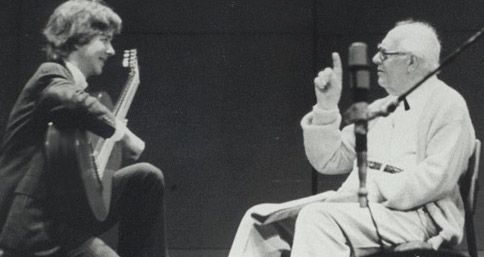
I could not have understood it then, but this apparently simple dismissal of a stylistic performance/compositional trait of the past had tentacle-like ramifications reaching into the way we view music of the past and the confusion between, in Richard Taruskin’s terms, “text and act.”[44]
In Early Recordings and Musical Style: Changing Tastes in Instrumental Performance, 1900-1950, Richard Philip chronicles the decline of the portamento for strings and voice as reflected in recordings beginning in the 1930s. When portamenti were used after the 1930s, they were less prominent.[45] It will be helpful to establish the ubiquitous nature of the portamento up to the 1930s; to explore several explanations for its decline to place Segovia’s facile rejection of portamento in context; to look at portamento on the guitar to see the ways in which it is similar and the ways in which it is different from portamenti performed on other instruments; and, finally, to offer a few suggestions for the application and execution of the portamento.
USE OF PORTAMENTO
The use and function of portamento in the (late) eighteenth and nineteenth centuries is well documented by a variety of authors. In The Historical Performance of Music: An Introduction, Colin Lawson and Robin Stowell state that “Portamenti served to shape the melody by calling attention to certain structurally important pitches. This was already a prominent feature of the technique of some violinists well before 1800 and subsequently found its way into orchestral playing, early recordings reflecting a well-established approach.”[46] In Classical and Romantic Performing Practice, 1750-1900, Clive Brown devotes an entire section to documenting the use of and contemporary attitudes towards portamento.[47] Robert Philip, in Early Recordings and Musical Style, painstakingly chronicles the performance styles of the earliest recording artists and convincingly suggests that, “In the use of vibrato and portamento, in flexibility of tempo, and in detailed rhythmic style, the performers of the early twentieth century can be heard moving towards what we now think of as modern style, and away from earlier practice—that is, the practice of the nineteenth century.”[48] This means that performances heard on early twentieth-century recordings represent the end of a long-standing performance tradition[49] and that “in fundamental ways, musicians from early in our century were closer to the traditions of Beethoven’s day than we are now.”[50]
In general, the nineteenth-century portamento was an audible shift used to expressive advantage. The word suggests the act of “carrying” the sound of one note to another. Carl Flesch regarded it as an “emotional connection of two tones.”[51] In addition to its expressive content, the portamento, like many nineteenth-century performance practices, provides an audible analysis and “outlines the shape of the melody and signals important structural events. In a sense, the performer provides the listener with an analysis of the melody by using the ornament to accentuate high notes and to herald suspensions and cadences. Far from being an example of slovenliness in execution, the portamento shows the care and thoughtfulness applied to the musical text by nineteenth-century string players.”[52]
PORTAMENTO OR GLISSANDO?
The New Grove Dictionary of Music states that in a portamento one hears the sliding from one pitch to another, but not the intervening pitches, whereas in the glissando one can distinguish individual pitches.[53] This distinction is also made in the second edition of the Harvard Dictionary of Music[54] although earlier reference books present the terms as synonymous.[55] The guitar is capable of both glissando and portamento: a slow slide will reveal the pitches between the two notes as the finger slides over the intervening frets while a faster and lighter slide will render them inaudible.
Emilio Pujol, in his Escuela razonada de la guitarra of 1934, defined an arrastre or glissando[56] as a slur performed with one finger by sliding, but he reserves the term portamento for that which is “partly an arrastre, by its beginning, and partly slur, by its end.”[57] We’ll look at Pujol’s examples of glissando, termed arrastre by him, and present a few illustrations from compositions and transcriptions by Tárrega.
ARRASTE OR GLISSANDO?
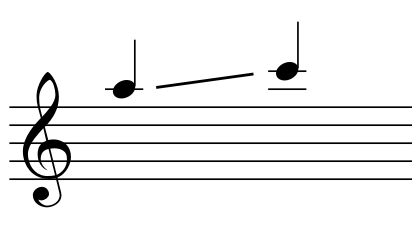
Example No. 1: Pujol’s arrastre or glissando
The arrastre or glissando is fairly rare and is used primarily for whole-steps and half-steps when a slur proper is not possible:
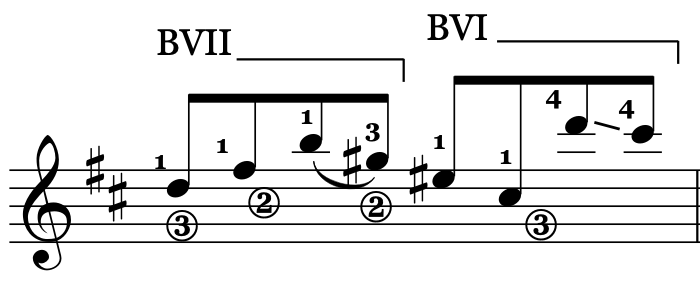
Example No. 2: J. S. Bach, Bourée, BWV 1002, trans. Tárrega, m. 59
It can also be found very occasionally for larger intervals:

Example No. 3: Francisco Tárrega, Danza mora, m. 46
Arrastre or glissando with accent on first note:
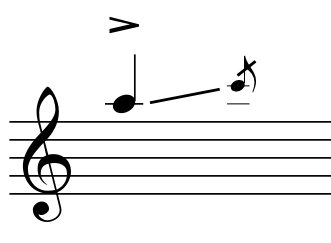
Example No. 4: Pujol’s arrastre or glissando with accent on first note
This glissando makes no sense and cannot be found in the works of Tárrega. I wonder if Pujol included it to have a complete taxonomy. To what note is the slide connecting? If it’s a “c,” then it’s identical to the arrastre or glissando with an articulated second note (see below). And if it connects to another note, where is it, and how does one get there?
Arrastre or glissando with accent on second note:

Example No. 5: Pujol’s arrastre or glissando with accent on second note
This form of glissando is very common and is used with frequency by Tárrega. Care must be taken not to overemphasize the small note, especially as the main note remains unarticulated:
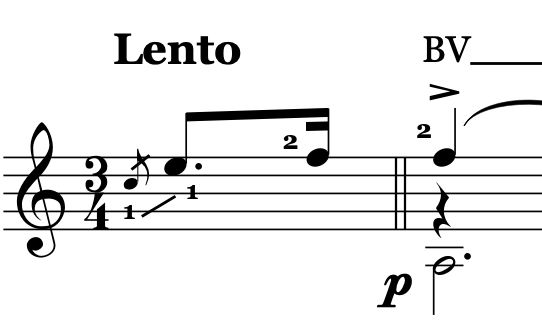
Example No. 6: Francisco Tárrega, Marietta, m. 1
Arrastre or glissando with an articulated second note:
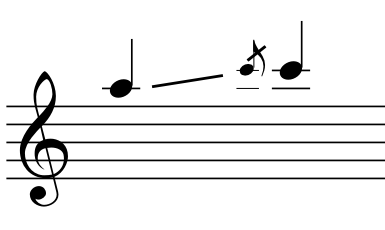
Example No. 7: Pujol’s arrastre or glissando with an articulated second note
This form of glissando is ubiquitous in the works of Tárrega. Note that the small note is not a grace note, only an instruction to strike the second note (on the beat) with a right-hand finger, indicating that the importance of the ornament lies in the connection between the two notes. In Example No. 8 below, Tárrega wants an audible glissando highlighting the return of the theme, otherwise there would be no point to the notation:
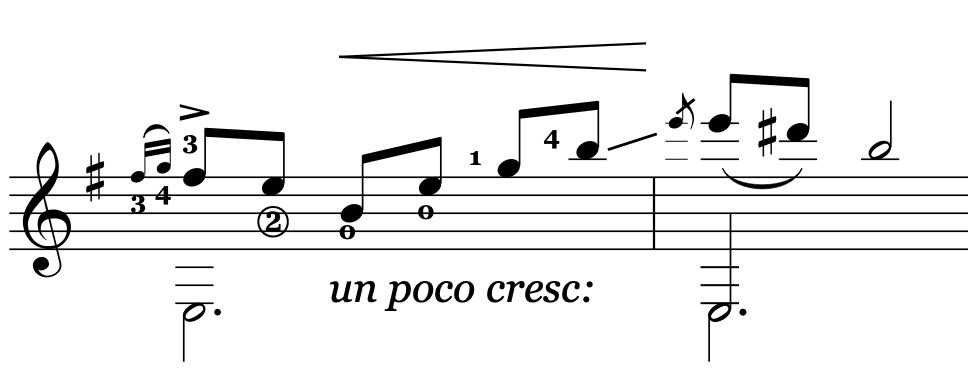
Example No. 8: Francisco Tárrega, Adelita, mm. 4-5
None of these examples is termed portamento by Pujol. He reserves that term for a combination of arrastre and slur. This is his proposed notation, which never gained acceptance, but it expresses the intended means of execution, a slide to an intermediate note a diatonic third below the arrival note, followed by a slur:
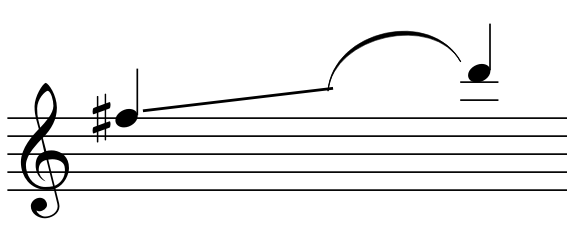
Example No. 9: Pujol’s example of a combination arrastre-and-slur portamento
Here the first finger slides to a note a diatonic third below the arrival note and then the fourth finger performs a slur to the arrival note. Pujol writes that the “portamento is often indicated by the same sign as the slur.”[58] When you encounter a large interval under a slur or glissando line, as in this excerpt from Capricho árabe, consider the arrastre-and-slur form of execution:

Example No. 10: Francisco Tárrega, Capricho árabe, m. 51
A correct interpretation of Tárrega’s notation in Example No. 10 could be:

Example No. 11: Francisco Tárrega, Capricho árabe, m. 51
Another possibility, given the freedom and discretion afforded players of the day, might be to strike the arrival note:
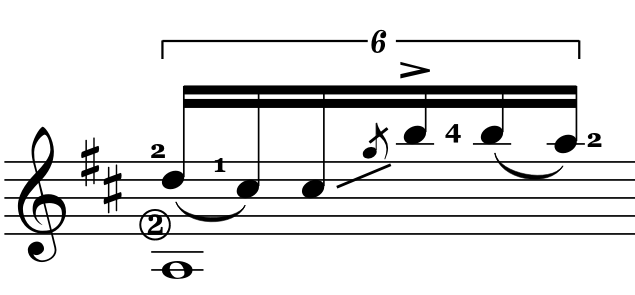
Example No. 12: Francisco Tárrega, Capricho árabe, m. 51
Pujol clarifies the execution in his example for the slur-and-arrastre form of portamento. Here the slur is performed before the slide:

Example No. 13: Pujol’s example of a combination slur-and-arraste portamento
This leads to the possibility of this execution:

Example No. 14: Francisco Tárrega, Capricho árabe, m. 51
or this:
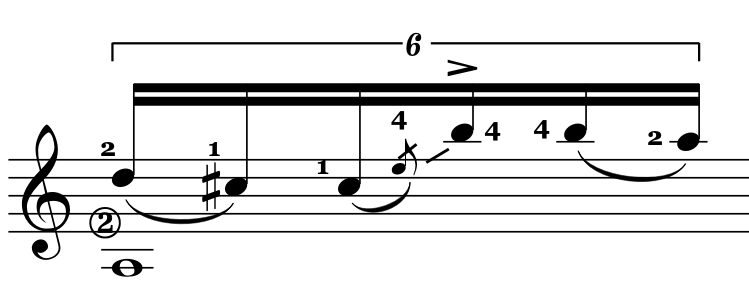
Example No. 15: Francisco Tárrega, Capricho árabe, m. 51
I wonder if Pujol had a copy of Carl Flesch’s Die Kunst des Violinspiels (1923) in front of him as he wrote. Flesch distinguishes between:
- An uninterrupted slide on one finger
- A slide in which one finger slides from the starting note to an intermediate note, and a second finger stops the destination note
- A slide in which one finger plays the starting note, and a second finger stops the intermediate note and slides to the destination note.[59]
Flesch’s “uninterrupted slide on one finger,” corresponds to Pujol’s “slur performed by one finger by sliding.”
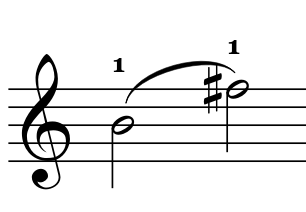
Example No. 16: Flesch’s uninterrupted slide on one finger
Flesch’s “slide in which one finger slides from the starting note to an intermediate note, and a second finger stops the destination note,” or the B-portamento, as he termed it (because the intermediate note is played with the beginning finger), corresponds to Pujol’s “partly an arrastre, by its beginning, and partly slur, by its end.”
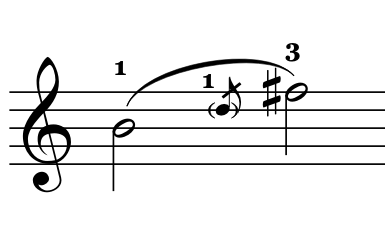
Example No. 17: Flesch’s B-portamento
And Flesch’s “slide in which one finger plays the starting note, and a second finger stops the intermediate note and slides to the destination note,” or L-portamento (because the intermediate note is played with the last finger),
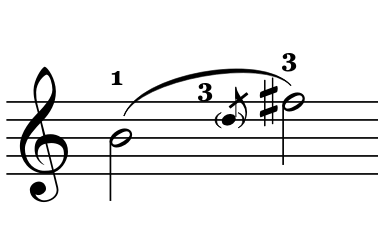
Example No. 18: Flesch’s L-portamento
corresponds to Pujol’s second form of portmento, which begins with a slur and ends with an arrastre. Flesch writes that The L-portamento was rejected by earlier teachers,[60] but he acknowledges that changing performance styles reflected its wider acceptance:[61]
Unfortunately, in this matter, as also in that of shading, no universally valid rules can be established, since not only the individual taste of the performer but also the spirit of the time has to be considered; not only the artist’s musical personality, but also the violinistic style of the period. If, sixty years ago, a daring student of a musical academy had formed the habit of using L-portamenti instead of B-portamenti, he certainly would have been expelled for perversion of musical taste. On the other hand, today a violinist who rejected L-portamenti on principle would be ridiculed as a fossil surviving from a period long past.
Other than indicating which note receives an accent, Pujol does not offer any information on the performance of the arrastre or portamento, such as when to use them or the speed of the slide. He seems primarily interested in his method with the classification of various guitar techniques and codifying notation. If his slur-and-arrastre portamento (Examples Nos. 13-15) is related to Carl Flesch’s L-portamento, it might be considered less common or desirable than the other forms, especially for late nineteenth- and early twentieth-century music.
DECLINE OF PORTAMENTO
There has been a variety of reasons put forth for the decline of the portamento. Daniel Leech-Wilkinson traces the portamento’s role as a significant expressive device for over a hundred years to its universal rejection as sentimental and self-indulgent. He then presents an argument which suggests that the key to its original effectiveness lay in its association with “motherese,” the loving and secure language of childhood.[62] If true, then our response to portamento inheres in the comfort of our earliest memories.
That our response to portamento is hardwired in our brains is central to his thesis. Combining work in developmental psychology, especially infant-caregiver communication, readings in music, and evidence from recordings, Leech-Wilkinson maintains that “portamento draws on innate emotional responses to human sound, as well as on our earliest memories of secure, loving communication, in order to bring to performances a sense of comfort, sincerity, and deep emotion.... Portamento, because of its association (however unconscious) with naïve trust and love, became embarrassingly inappropriate.”[63] And once this association became “embarrassingly inappropriate,” the use of portamento decreased substantially.[64]
“If anything about our response to portamento were hardwired in our brains,” he writes, “then we would need a powerful explanation for its widespread rejection over an increasingly lengthy period of time.”[65] Leech-Wilkinson suggests that portamento’s continued association with naïveté and innocence was rendered impossible by the Second World War.[66] Theodor Adorno provides a clear statement of the war’s cultural impact: “The idea that after this war life could go on as normal, that culture can be resurrected—as if the resurrection of culture would not itself be its own negation—is idiotic. Millions of Jews have been murdered and this should be an interlude and not the actual catastrophe? What exactly is this culture awaiting?”[67] After this, a return to innocence in music making was impossible.
Leech-Wilkinson closes his argument with the observation that once portamento was gone, performers had to replace it with something. These replacements manifested themselves haphazardly: performers increased their use of vibrato in nineteenth-century music, they became coolly objective in the performance of Bach, and they eschewed any expressivity in avant-garde music.[68]
An equally compelling idea is that the decline of portamento is related to what Mark Katz terms the “phonograph effect.” Katz maintains that the improvisatory and spontaneous nature of the portamento sounded artificial when heard repeatedly. Additionally, early microphones were incapable of reproducing it accurately and exaggerated its flaws.[69] As different sets of artistic criteria were emerging for live and recorded performances concurrent with the new technology, it was the criteria for recorded performances that ultimately began to inform live performances. At the beginning of recorded sound it could only be the other way about: performance criteria informed recordings.
While most of the research on the use of portamento has focused on singing or string playing, guitarists possess the same antipathy to the portamento as other modern instrumentalists and singers. Without negating the importance of the ideas presented by Daniel Leech-Wilkinson and Mark Katz, or the thought that guitarists would have been subject to the same cultural and technological forces as others, the move from gut to nylon strings after 1947 might have further encouraged guitarists to turn away from the use of portamento. The higher string tensions made possible by nylon may have created a harsher sound as the nylon came in contact with the frets during the slide.
EXECUTION OF PORTAMENTO
As might be expected, written sources provide a variety of suggestions, some conflicting, about the execution of the portamento, and while early recordings document the extensive use of portamento, they reveal no application of consistent rules.[70]
Nineteenth-century guitarists are mostly silent about the portamento, although, in his method from 1825, Matteo Carcassi wrote:
The glissando or portamento is executed by a single left-hand finger sliding along the neck while passing over all the frets between the first and the second note, after having struck the first of the two notes with the right hand. The glissando produces a good effect on the guitar because it imitates the portamento of the voice.[71]

Example 19: Carcassi’s illustration of the glissé or porté
In his New Guitar Method from 1843, Dionisio Aguado gives us two sentences about how to perform the arrastre:
The arrastre can be performed in two ways: either by sliding the finger sharply and rapidly along the string to its position, or by bringing its weight down on each of the frets it crosses, although fairly lightly. The execution of either method can be graduated.[72]
This is curious. Does Aguado intend us to hear the intervening pitches when we bring the finger down on each of the frets it crosses? The thought is intriguing. Consider this example from Ferdinand Pelzer’s Instructions for the Spanish Guitar (1833):

Example 20: “Glissato or Slide” from Ferdinand Pelzer’s Instructions for the Spanish Guitar (1833)
Pelzer wrote:
The Glissato or Slide is played by striking the first small note, and whilst the string is in a state of vibration, sliding the finger by which it is pressed along all the semitones of frets, until it arrives at the note of the melody. The Bass note is to be played with the first of the small notes.[73]
It is difficult to determine whether the phrase, “along all the semitones of frets,” is meant to describe a physical action, a musical effect, or both. To my knowledge, however, Pelzer is the only writer who notated the intervening notes of a glissando or portamento.
Charles de Beriot, in his Méthode de violon (1858) describes “the ‘light and rapid’ portamento for fast passages, the ‘gentle’ portamento for passages of a tender character, and the ‘dragged’ portamento for sorrowful passages.”[74] H. Becker and D. Rynar, in their Mechanik und Ästhetik des Violoncellspiels (1929), posit four general rules for the execution of the portamento:
- One should perform... every portamento with a diminuendo;
- The further apart the notes which are to be joined lie, and the slower the sliding movement carried out, the more essential the diminuendo;
- One should never follow a portamento in one direction immediately with one in the opposite direction.
- One should accompany portamento with a vibrato when great passion, grief, deep emotion or the extinguishing of vital energy is to be depicted. However, this nuance should be executed only from a higher to a lower note.[75]
Joseph Smith, in Voice and Song (1907), writes that the portamento can be sung fast or slow, with a crescendo or diminuendo. “[A]n ascending portamento delivered crescendo is impassioned, that of a descending portamento delivered diminuendo is languishing.” He also states that the time used for the portamento is always taken from the end of the first note, never from the start of the arrival note.[76]
While these discussions are helpful, portamento on the guitar is not only different in degree from portamento on other instruments or for voice, it is different in kind, and it is this difference that should inform our approach to its execution. We cannot control the volume once we have played the main note, unlike bowed strings and voice, hence we cannot crescendo during a portamento, but we can control the speed of the slide and the amount of pressure the left-hand fingers apply to the strings.
With these thoughts in mind, I suggest:
- It is the relationship between the volume of the starting note and that of the concluding note that gives us our sense of crescendo or diminuendo. Guitarists do an especially poor job executing the arrastre with accent on the second note. The usual tendency is to launch into the first note with unrestrained vigor, drawing attention away from the primary note.
- Dynamic shape is enhanced by the speed of the slide, slower for a diminuendo and quicker for a crescendo.
- A slight increase in the speed of the slide right before the arrival note will serve to add emphasis to that note in those cases in which the arrival note is not played with a right-hand finger.
- Any intermediate note (as in the arrastre-and-slur forms of the portamento) should be inaudible.
- Whatever time is required for the portamento should be taken from the first note.
- Notated descending portamenti are less common than notated ascending portamenti in guitar music, which should be taken into account when introducing un-notated portamenti.
- Early recordings show great variety in the use of portamento: it was an ornament applied by the performer, presumably with taste and discretion.[77]
I wouldn’t hesitate to experiment with an increased use of portamento, even when not marked in the score, to highlight and clarify structural and climactic pitches. Carl Flesch states that portamenti between notes a third apart are the most common.[78]
CONCLUSION
Even with evidence of portamento as a legitimate performance practice, it remains seldom-used. It is a commonplace to realize that the early music movement, as it is sometimes called, has ceased to be a speciality and now influences almost all aspects of mainstream classical music. John Potter sums up the impact of this influence:
The fact that performers specializing in historically informed performance also choose to ignore portamento confirms that the ideological objections to it run very deep indeed. One explanation may lie in the origins of the early music movement.... A significant part of the early music agenda was to strip away the vulgarity, excess, and perceived incompetence associated with bizarre vocal quirks such as portamento and vibrato.[79]
Ellen T. Harris states that “…portamento is largely rejected in classical vocal music and opera. This so-called ‘pure’ style of singing, however, has no basis in vocal practice of the seventeenth, eighteenth, or nineteenth centuries.”[80]
Once we understand the reasons for the decline of portamento, perhaps we will see that this decline has more to do with us than with us than with portamento. And as we change our attitude towards portamento, we gain a significant and stylistically relevant interpretive device applicable to much nineteenth-century music.
T. S. Eliot, The Sacred Wood: Essays on Poetry and Criticism (London: Methune, 1920), 8. ↩︎
These oft-repeated goals were to redeem the guitar from the flamenco and folklore instruments; to create a repertory; to create a public for the guitar; to win the guitar a respected place in the great music schools along with the piano, the violin and other concert instruments. ↩︎
For an in-depth discussion of the performer as co-creator, see Daniel G. Barolsky, "Romantic Piano Performance As Creation," (Ph.D. dissertation, the University of Chicago, August 2005). ↩︎
See Erik Stenstadvold, “Coste’s Contribution to the Twenty Studies by Sor,” Soundboard, Vol. XI, No. 2 (1984), 136-140. ↩︎
Richard Savino, “Essential Issues in Performance Practices of the Classical Guitar. 1770-1850,” Performance on Lute, Guitar, and Vihuela: Historical Practice and Modern Interpretation, edited by Victor Anand Coelho (New York: Cambridge University Press, 1997), 195-219. ↩︎
Clive Brown, Classical and Romantic Performance Practice 1750-1900 (Oxford: Oxford University Press, 1999), 1-2. ↩︎
Josef Hofmann, *Piano Playing with Piano Questions Answered * (Philadelphia: Theodore Presser Co. 1920), x. ↩︎
Ibid., 54. ↩︎
Daniel G. Barolsky, Romantic Piano Performance As Creation (Ph.D. dissertation, the University of Chicago, August 2005), 210–211. ↩︎
Jacques Barzun, From Dawn To Decadence (New York: HarperCollins, 2000), 468. ↩︎
Ibid., 473. ↩︎
Arthur Krystal, “Annals of Letters: Age of Reason: Reporting and Essays,” New Yorker (October 22, 2007). ↩︎
James Francis Cooke, Great Pianists On Piano Playing (Philadelphia: Theodore Presser, Co., 1913) 213. ↩︎
Ibid., 280. ↩︎
Barzun, 473. ↩︎
Brown, 4. ↩︎
Fernando Sor, Twenty Studies for the Guitar, ed. by Andrés Segovia (New York: Edward B. Marks Music Corporation, 1945). ↩︎
Francisco Tárrega, Doce Composiciones, ed. by Isaias Savio (Buenos Aires: Ricordi Americana, n.d. [1969?]). ↩︎
Robert Spencer, “Nineteenth-Century Guitar Music: The Type of Edition We Should Play From,” European Guitar Teachers Association Guitar Journal No. 6 (1995), 15-18. ↩︎
Brown, 4. ↩︎
Ibid., 1-2. ↩︎
Ibid., 2. ↩︎
Andrés Segovia, Transcripciones (Obras para guitarra, vol. 3) ed. by Angelo Guardino and Phillip de Fremery (Ancona: Edizioni musicali Berbén, 2001). ↩︎
Isaac Albéniz, Mallorca, transc. by Andrés Segovia (New York: Celesta, 1947). ↩︎
Daniel Leech-Wilkinson, “What We Are Doing with Early Music Is Genuinely Authentic To Such a Small Degree That the Word Loses Most of Its Intended Meaning,” Early Music, Vol. XII, No. 1 (Feb., 1984), 15. ↩︎
Margaret Bent, “‘Authentic’ Listening?,” Early Music, Vol. XXV (1997), 567. ↩︎
Barzun, Dawn To Decadence, 336. ↩︎
Alexis de Tocqueville, Democracy in America (New York: Knopf, 1951), II, 99. ↩︎
Neal Gabler, Life the Movie: How Entertainment Conquered Reality (New York: Vintage Books, 2000), 19. ↩︎
Ibid., l6. ↩︎
Morris Berman, The Twilight of American Culture (New York, Norton, 2000), 130. ↩︎
Jacques Barzun, The Culture We Deserve:A Critique of Disenlightenment (Middletown, Connecticut: Wesleyan, 1989), 135. ↩︎
Andrew Keen, The Cult of the Amateur (New York, Doubleday, 2007), 35. ↩︎
Felicia R. Lee, “Are More People Cheating? Despite Ample Accounts of Dishonesty, a Moral Decline Is Hard to Calculate,” New York Times (October 4, 2003), Arts Section. ↩︎
Keen, 36. ↩︎
Berman, 151. ↩︎
Christopher Lasch, The Culture of Narcissism: American Life in an Age of Diminishing Expectations (New York: Norton, 1991), 145. ↩︎
Susan Jacoby, “How the Word ‘Elite’ Became a Slur," New York Times (May 30, 2008), Op-Ed contributor. ↩︎
Patricia Cohen, “Dumb and Dumber: Are Americans Hostile to Knowledge?” New York Times (February 14, 2008), Arts section. ↩︎
Barzun, Culture, 4. ↩︎
Keith Windschuttle, The Killing of History (San Francisco, Encounter Books), 311. ↩︎
Lasch, 7. ↩︎
Ibid., 152. ↩︎
Richard Taruskin, Text and Act (Oxford, 1995). ↩︎
Robert Philip, Early Recordings and Musical Style: Changing Tastes in Instrumental Performance, 1900–1950 (Cambridge: Cambridge University Press 1992), 229. ↩︎
Colin Lawson and Robin Stowell, The Historical Performance of Music: An Introduction (Cambridge: Cambridge University Press, 1999), 144-145. ↩︎
Brown, 558-587. ↩︎
Philip, 207. ↩︎
Ibid., 238. ↩︎
Robert Philips, “Traditional Habits of Performance in Beethoven Recordings,”Performing Beethoven, ed.by Robin Stowell (Cambridge: Cambridge University Press, 1994), 195-204. ↩︎
Carl Flesch, *The Art of Violin Playing *(New York: Carl Fischer, 1924), 1, 29. ↩︎
Jon W. Finson, “Performing Practice in the Late Nineteenth Century, with Special Reference to the Music of Brahms,” The Musical Quarterly, Vol. LXX, No. 4 (Autumn, 1984), 466. ↩︎
David D. Boyden and Robin Stowell, “Glissando,” The New Grove Dictionary of Music and Musicians, ed. by Sir Stanley Sadie, 2nd ed. (London etc.: Macmillan, 2001), X, 13-15. ↩︎
Willi Apel, ed., Harvard Dictionary of Music (Cambridge, Massachusetts: Belknap Press), 1944. ↩︎
See, for example,Dictionary Of Musical Terms, Compiled and Edited by Dr. Th. Baker (New York: G. Schirmer), 1909. ↩︎
I doubt that Pujol made the “intervening pitch" distinction between glissando and portamento—at least he doesn’t mention it in his method—and I’m not implying one in his definitions. ↩︎
Emilio Pujol, A Theoretical Practical Method for the Guitar Based on the Principles of Francisco Tárrega, Vols. 1 & 2, trans. by Brian Jeffery, ed. by Matanya Ophee (Boston: Editions Orphée, 1983), 46. ↩︎
Ibid., 46. ↩︎
Philip, 144. ↩︎
Ibid. ↩︎
Carl Flesch, Violin Fingering: Its Theory and Practice (Milan, Edizione Curci, 1960; English translation and adaptation (London: Barrie & RocklifF, 1966; reprint New York: Da Capo Press, 1979), 329. ↩︎
Daniel Leech-Wilkinson, “Portamento And Musical Meaning,” Journal of Musicological Research, Vol. XXV, No. 3-4 (July, 2006), 259. ↩︎
Ibid., 234. ↩︎
Ibid., 260. ↩︎
Ibid., 235. ↩︎
Ibid., 251. ↩︎
Cited in Leech-Wilkinson, 251. ↩︎
Ibid., 261. ↩︎
Mark Katz, “Portamento and the Phonograph Effect,” Journal of Musicological Research, Vol. XXV, No. 3-4 (July, 2006), 1-33. ↩︎
Colin Lawson and Robin Stowell, The Historical Performance of Music: An Introduction (Cambridge: Cambridge University Press, 1999), 144-145. ↩︎
Matteo Carcassi, Methode complète pour la guitare, Op.59 (Paris: Carli, 1825; reprint: Geneva: Editions Minkoff, 1988), 39. My translation. ↩︎
Dionisio Aguado, New Guitar Method, ed. by Brian Jeffery, trans. by Louise Bigwood (London: Tecla Edition, 1981), 177. ↩︎
Ferdinand Pelzer, Instructions for the Spanish Guitar (London: Chappell Music, 1833), 50. ↩︎
Philip, 213. ↩︎
Quoted in Philip, 152. ↩︎
Joseph Smith, Voice and Song (New York: G. Schirmer, 1907), 113. ↩︎
For a detailed analysis of the decline of portamento in early recordings, see Chapter 6, “Solo Portamento,” in Robert Philip, Early Recordings and Musical Style: Changing Tastes in Instrumental Performance, 1900-1950 (Cambridge: Cambridge University Press, 1992), 143-178. ↩︎
Flesch, Violin Fingering, 338. ↩︎
John Potter, “Beggar At The Door: The Rise and Fall of Portamento In Singing,” Music and Letters, Vol. LXXXVII, No. 4 (November, 2006), 27. ↩︎
Ellen T. Harris, “Portamento (i)," The New Grove Dictionary of Music and Musicians, ed. by Sir Stanley Sadie, 2nd ed. (London etc.: MacMillan, 2001), XX, 182–183. ↩︎
